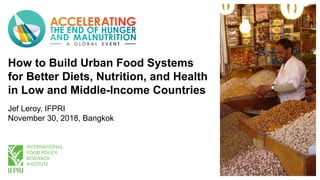
How to Build Urban Food Systems for Better Diets, Nutrition, and Health in Low and Middle-Income Countries
- 1. How to Build Urban Food Systems for Better Diets, Nutrition, and Health in Low and Middle-Income Countries Jef Leroy, IFPRI November 30, 2018, Bangkok
- 2. Side event agenda JEF LEROY Senior Research Fellow IFPRI CORINNA HAWKES Professor of Food Policy City University of London MATTHEW KOVAC Executive Director Food Industry Asia
- 3. Why focus on the urban poor? 0 10 20 30 40 50 60 70 80 90 100 19801990200020102020203020402050 %urabn World Europe LAC North America Africa Asia United Nations, Department of Economic and Social Affairs, Population Division (2018). World Urbanization Prospects: The 2018 Revision, custom data acquired via website. Most people are in cities… 0 1 2 3 4 5 6 7 8 1980 1990 2000 2010 2020 2030 2040 2050 billionpeople … especially in Africa and Asia 39% 68%
- 4. Urban poor suffer from all forms of malnutrition The urban poor suffer from all forms of malnutrition o Stunting: o 1 in 3 stunted children lives in a city o Rapid decline in rural areas but stable in urban areas o Overweight and obesity: prevalence higher in urban areas o Micronutrient deficiencies (very limited data) NUTRITIONAL STATUS
- 5. Changes in urban diets drive nutritional status NUTRITIONAL STATUS
- 6. Changes in urban diets drive nutritional status • Poor-quality diets drive all forms of malnutrition • “Nutrition transition” faster in urban than rural areas • Traditional diets consisting of coarse grains, staple cereals, and pulses → diets high in sugar, salt, saturated fat • Increasing consumption of ultra-processed foods NUTRITIONAL STATUS
- 7. Changes in urban diets drive nutritional status • Poor-quality diets drive all forms of malnutrition • “Nutrition transition” faster in urban than rural areas • Traditional diets consisting of coarse grains, staple cereals, and pulses → diets high in sugar, salt, saturated fat • Increased consumption of ultra-processed foods NUTRITIONAL STATUS 0 5 10 15 20 25 Q1 Q2 Q3 Q4 Q1 %oftotalenergyfromfree sugar % of total energy from ultraprocessed foods (quintiles) The share of ultra-processed foods determines the overall nutritional quality of diets in Brazil (Costa Louzada et al, PHN, 2017) WHO guideline
- 8. Changes in urban diets drive nutritional status • Poor-quality diets drive all forms of malnutrition • “Nutrition transition” faster in urban than rural areas • Traditional diets consisting of coarse grains, staple cereals, and pulses → diets high in sugar, salt, saturated fat • Increased consumption of ultra-processed foods • Nutrition transition contributes to the double-burden of malnutrition • Coexistence of undernutrition with overweight, obesity, and diet-related noncommunicable diseases. • NCDs are the leading cause of death globally (71% of all deaths in 2016) NUTRITIONAL STATUS
- 9. Individual and household factors shape diets of the urban poor
- 10. Individual and household factors shape diets of the urban poor • Urban dwellers purchase most of their food: • Recent 18-country study: 40% of urban dwellers in low-income countries could not afford the recommended fruit and vegetable consumption • Livelihoods often depend on unstable informal-sector employment • Less access to social safety nets (compared to rural counterparts), leaving the urban poor more vulnerable to income and food-price shocks. • Women engaged in the workforce in urban areas with limited childcare options • Time constraints, housing conditions and limited access to cooking facilities: • Drive urban dwellers toward the convenience of processed and ultra- processed ready-to-eat snacks and foods, street foods, and quick meals • Increase the risk of overconsumption of energy, added sugar, salt, and saturated fat
- 11. Urban diets are inextricably linked to the food environment
- 12. Urban diets are inextricably linked to the food environment • The food environment in urban areas is rapidly changing • Urban dwellers generally have access to a more diverse food supply than individuals in rural areas, but… • …are exposed to • aggressive marketing of ultra-processed foods • modernizing food retail sector, accelerated spread of supermarkets • supermarkets which increase access to energy-dense and nutrient-poor ultra-processed foods.
- 13. The urban food environment is part of the food system
- 14. The urban food environment is part of the food system • Globalization and trade liberalization have changed urban food system • Urban demand can drive rural transformation in peri- urban areas where foods are produced • Informal food vendors and processors: • Important source of food for the urban poor • Poor governance threatens livelihoods of vendors, often women
- 15. Addressing the urban poor’s nutrition problems requires better evidence • Diets • What do poor urban dwellers eat (especially the poor)? • Where do they procure their food/meals? • What are the drivers of healthy and unhealthy food choices? • Food environment • How does it affect food choice? • How can we map and characterize the quality of food environment? • Food system • What are the opportunities for leveraging food systems and food environments to improve urban diets? • How can urban/rural linkages be strengthened to improve diets in urban areas and stimulate rural transformation? ?
- 16. Urban food systems for better diets, nutrition, and health – a new IFPRI research program
